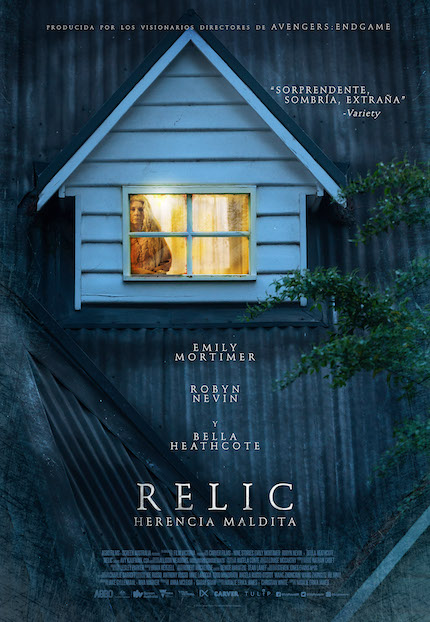RELIC Interview: Director Natalie Erika James on Her Deeply Personal Horror Film

In Relic, now playing in Mexican theaters thanks to Tulip Pictures, Kay (Emily Mortimer) and her daughter Sam (Bella Heathcote) travel from Melbourne to Creswick, Australia, after being notified by the police of the disappearance of Edna (Robyn Nevin), the family's grandmother.
Inside the house, located in a remote wooded area, Kay and Sam find rotten fruit, post-it notes with directions (“take pills”), and no trace of where grandma might be. Clearly the family hasn’t communicated recently, although Kay knew of her mother's mental decline. She even remembers how Edna called her scared because she believed someone was breaking into her house.
Director Natalie Erika James, of Australian and Japanese descent, uses a classic horror setting – the haunted house – to develop a highly personal film. James revealed, in an interview with ScreenAnarchy, that her own grandmother suffered from Alzheimer's for a number of years before she passed away. “I actually started writing Relic when I was on a trip to go see her in Japan. Unfortunately this was the first time she couldn’t remember who I was. It had a big impact on me.”
Like other productions of the so-called “new wave of arthouse horror”, such as The Babadook and His House, Relic takes place mainly in a single location, where the bad vibes are incessant. Grandma Edna's house is run down, messy, and could have a supernatural presence. Kay can't avoid having nightmares tied to the past of the property and her family.
James recalled how she spent all her childhood summers at her grandmother's house: "It always really scared me as a kid at nighttime, I had childhood nightmares associated with the place. The haunted-house genre was really useful because your house is so much about you as a person. The root of psychological horror isn’t about outside forces eating the home, it’s more about the horrors that are already locked inside your house and, by extension, yourself. It kind of draws on gothic horror as well, the suspension of what’s in the mind, what’s real and supernatural.”
The director and co-writer added: “The house represents a lot of things, it’s the last relic of happier times. It’s the idea that the stuff that you accumulate functions as your memories and what you built your identity on. The idea of a space that’s warping, a familiar space becoming unfamiliar and a really twisted labyrinth of sorts where you get lost.
"My grandmother had a couple of rooms upstairs that were just full of stuff, and as she worsened her hoarding got worse as well. I interpreted that to mean, from a poetic sense, that she was trying to hold on to things as things were slipping away in her mind. It was a sense of trying to keep something safe or stable around her. Hence why there’s this hoarding room in Relic and the labyrinth really grows from there. This felt like the right combination of the thematic concerns as well as something just scary.”
When Edna reappears as if nothing had happened, the severity of her illness is evident to her family. Among the most effective, difficult and emotional sequences in Relic are those starring the grandmother that address the inevitable: the mental and physical deterioration of an old woman with dementia.
For James it was “really important not to demonize people with Alzheimer’s. It was important that we do experience the story from Edna’s perspective at key points so that you have a deep compassion for the character. It’s a transformation, whether you want to call it a monster, we call her the other. There’s a few ideas in there, one of them is physicalizing decay through the mold growth, other is the deterioration of not just your mind but your body as well through aging.
"Also, capturing the uncanniness of someone you love who for a while looks the same but feels like they’re becoming someone different on the inside. And then at the end of their lives, to really see their humanity and fragility. That was really key in designing the monster or the other: that we weren’t making her too inhuman or too creature-like, because we really wanted it to relate to the most fragile human form.”
In Relic, the protagonists hug their loved one just as the "monstrosity" of the disease has consumed her.







